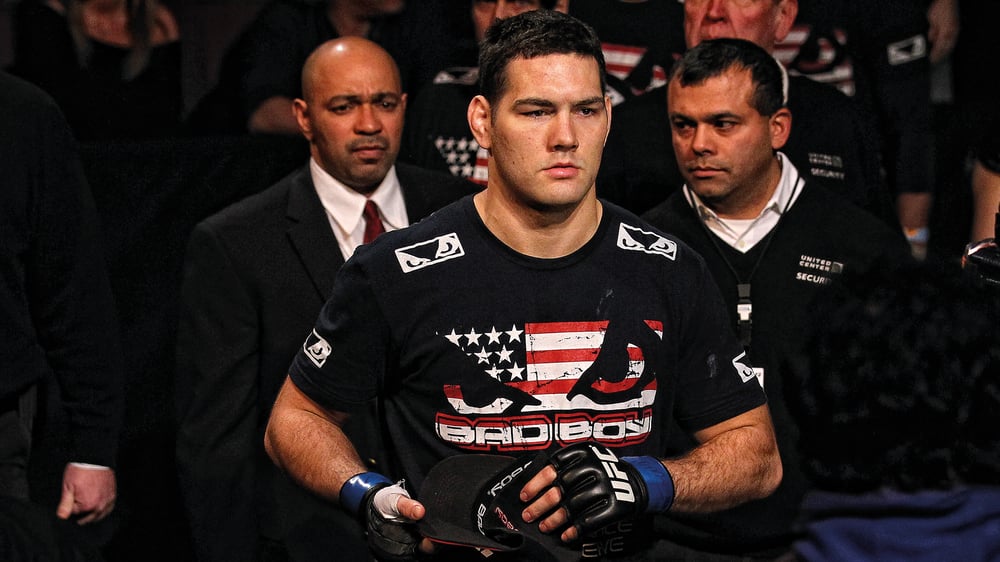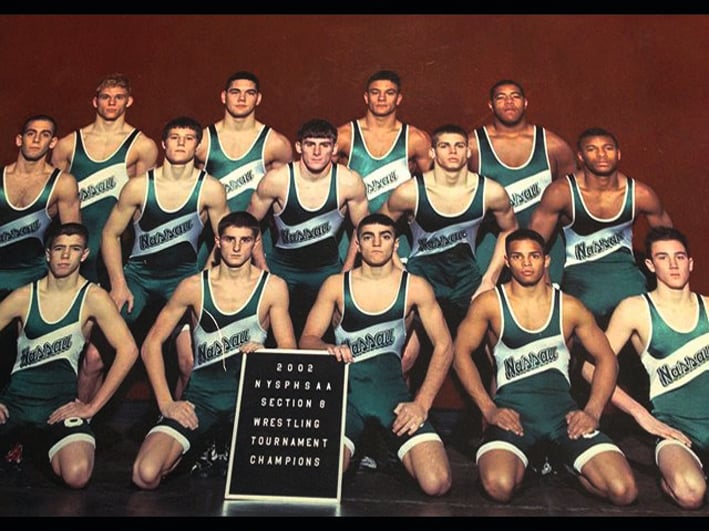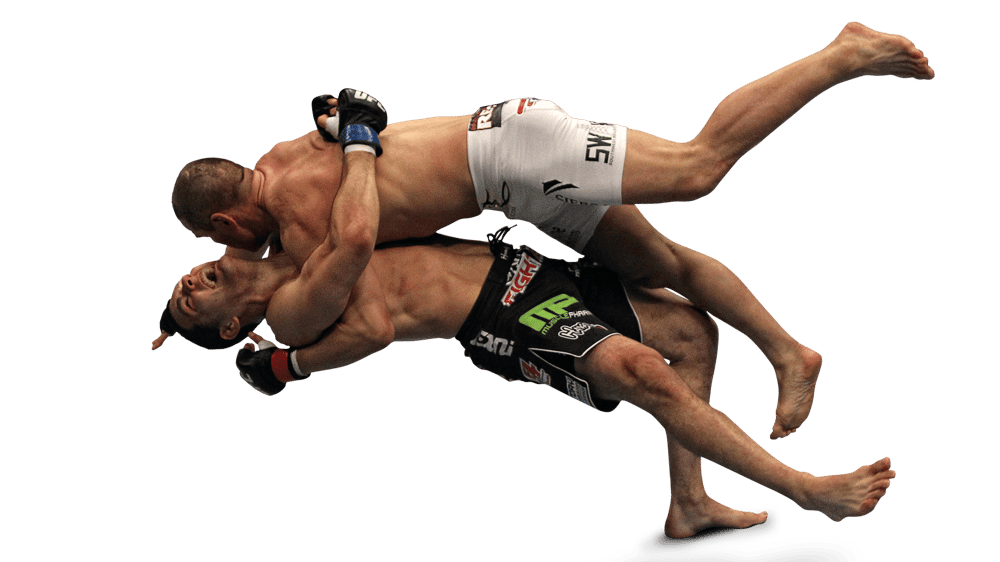
Issue 097
January 2013
Novice or not, Chris Weidman believes middleweight master Anderson Silva is hiding from him. But in 2013 the Long Island native is determined to land in the Brazilian master’s web and claim his shot at UFC immortality.
Nine fights. That’s all you’ll find on the mixed martial arts ledger of Chris Weidman. Yet, despite being thin on the ground in the stats department, many believe the fiercely ambitious New Yorker to be the best middleweight in the world not called Anderson Silva. And it’s Weidman’s plan to change even that in the coming months.
“Three months ago, when the UFC asked Silva to take the fight with me, I was really excited about it,” he tells FO. “But then he decided he didn’t want to fight until 2013. That p**sed me off a bit. Obviously, he’s since fought Stephan Bonnar, which is another kick in the teeth, but I’m over it now. I’ve got to move forward with my own career and make sure I force the title shot by beating everybody else in the division.
“There is no reason for him not to fight me. After he fought Chael Sonnen, he said he wanted to fight three months later as he was completely healthy. But then I dominate Mark Munoz and his manager says I don’t have enough experience.”
The ‘E’ word grates Weidman more than any other, for the simple fact the 28-year-old believes in the quality not quantity principle. “I could have 40 fights against bums and still have zero experience against good guys,” he says. “The amount of fights you have doesn’t matter. I’ve had nine fights, but they’ve all been against tough guys. My last two opponents have been top-five fighters.
“Michael Bisping has been in the UFC for six years and has had a bunch of fights, but he’s only beaten one top 10 guy in his whole career. How is he more experienced than me? Just because he’s had a lot of fights, doesn’t mean he’s fighting good guys and learning. He’s fought four tough guys in his career – Wanderlei Silva, Chael Sonnen, Dan Henderson and Rashad Evans – and lost to every single one of them. So why does anyone want to see Anderson Silva beat him?”

Looking back, Weidman will be the first to admit he’s far more experienced than his nine bouts suggest. And though he’d later become a celebrated mixed martial artist, and indeed college wrestler, it was in the living room and back garden where Weidman first made his name and learned to fight. Before Matt Serra and Ray Longo, it was his older brother, Charlie, who showed him the art of war.
In fact, Charlie Weidman is, at least in the eyes of his brother, the UFC star that got away. It was him, not Chris, whose path seemed destined to land him in the big leagues of either professional fighting or football.
But, as is so often the case, a career-crushing injury put paid to Charlie’s sporting aspirations and Chris, the younger brother and childhood foe, eventually began to take over, buoyed by the beatings and eager to match and surpass the glowing athletic reputation of his elder sibling.
“I was always trying to follow my brother around and become what he was,” says Weidman, who signed for the UFC after just four pro fights. “He was a very tough and scary dude. I’d have to take a number of beatings from him and his friends growing up, and, yeah, it sucked, but it helped me in the long run.
“He was supposed to be the UFC fighter, not me. Ask anybody in our family and they’ll say the same. I was the quiet one. Around my family, I didn’t talk much at all, because they were all very loud and opinionated. My brother was a very good athlete, a good wrestler and he’d probably be in the NFL now had he not blown out his knee. I don’t think any athlete has been able to continue with the kind of surgery he had to endure. It’s a shame. He was an extreme athlete, and I was just his little brother.”
That’s not to say Chris paled in comparison, of course. Far from it. In time, the younger Weidman was every bit as competitive and successful.
“I took first place in my first wrestling tournament and at the end of the season the head wrestling coach gave me an MVP T-shirt, and that meant a lot to me,” he reveals. “That really made me feel like a wrestler. I was the only second grader in the room – too young to compete – and they only let me get involved because of who my older brother was.”
Like his brother, Chris was also a master of many sports, not content with just one field or activity. In addition to wrestling, Weidman showed immense promise on the ice rink, with a stick in hand and puck at his feet. “Hockey was my thing, without question,” he says. “I think I still hold the record for most goals in my hometown. That was back when I was in elementary school, but they all count. I was pretty good, and my goal was to become an NHL hockey player.
“Even after I wrestled, I tried out for the Olympic hockey team and had my dreams set on making my name in hockey. I bought all my hockey equipment, even though I hadn’t played competitively since the seventh grade now, and told my wife I was going to get back into it and play for the New York Islanders. I figured I was pretty athletic and could pick it up fast. So I spent $500 on the equipment – my wife wanted to kill me – and then I played one weekend with these high school kids and realized I was no longer the player I thought I was.”

The death of his hockey dream created openings elsewhere, however. Mixed martial arts, a fusion sport that embraces all collegiate wrestlers, caught the New Yorker’s attention and wouldn’t let go. It combined everything he loved about sport. Competition, physicality and wrestling. It was, in essence, the direction his brother had been pushing him towards since they first slugged each other on the nose and laughed it off. Moreover, it was a course on which Weidman, a two-time NJCAA All-American and a two-time NCAA Division 1 All-American at Hofstra, felt comfortable enrolling.
“Wrestling is a huge part of any success I’m going to have, both in MMA and life in general,” he readily admits. “It has made me who I am today. It’s not just my base in terms of takedowns, takedown defense, scrambles and top control, but it has also molded the discipline and mental side of my game. That’s what really carried over into MMA. It’s my foundation as a human being, not just the foundation of my fighting style.”
Before making the move into mixed martial arts, Weidman bridged the gap by getting to grips with jiu-jitsu, under the tutelage of former UFC welterweight king Matt Serra. The Long Islanders hit it off instantly, and Weidman struck up a similarly tight bond with the so-called ‘peaceful art.’
He says: “I thought jiu-jitsu was cool and another thing to have fun with. I did three months of jiu-jitsu and then had my first Grapplers Quest tournament for $1,000 and won my weight class. I also won the absolute division, which was all the divisions combined. All together, I had 13 matches and won each of them by submission. And that was the first time I’d ever won any sort of money for competing, so it felt extra special.”

The financial gain opened Weidman’s eyes and pretty soon his attention was solely focused on diving in amongst the sharks of MMA. In pursuit of money and a future, the hungry scrapper made his way to Ray Longo’s MMA Academy and prepared to supplement his wrestling and recently acquired jiu-jitsu talents with a spot of punching and kicking. But if you think he was in the slightest bit intimidated, you’d be wrong.
“I grew up boxing – not organized boxing, but backyard stuff,” the 28-year-old says. “As kids we used to put on gloves and fight each other when there was nothing else to do. So I was never afraid of conflict or getting punched in the face. I loved the sparring element. Even when I was getting beaten up, which happened frequently when I started out, I still kept the faith and believed I’d get my own back when my sparring partner began to tire.”
Longo tightened up the technique, while Serra continued to drill the groundwork, and in a matter of months Weidman was deemed ready to make his professional mixed martial arts debut. In February 2009, competing as a middleweight, he submitted Brazilian jiu-jitsu black belt Reubem Lopes, with a kimura at 1:35 of the first round. As far as opening statements go, he couldn’t have shouted any louder.
“I had a crazy amount of pressure on me for my first fight,” Weidman recalls. “There were a lot of people expecting big things from me, so it was a big relief to get that fight done and become an official MMA fighter.
“I’m a psychology major, and that definitely helps when it comes to dealing with pressure and understanding the brain and how it works. I know where my head needs to be in order to succeed. My philosophy is a simple one: work as hard as I can in training and then do exactly the same thing in the cage. And have fun.”
It was this that prepared Weidman for the ultimate step-up when, four fights into his career, the UFC came-a-knocking in 2011. He had a choice to make. Either accept a UFC bout with Alessio Sakara on two weeks’ notice, or look the other way and pass the opportunity up. “I took that fight... and had a fractured rib, so I couldn’t train at all,” he says.
“I didn’t spar, hit pads, roll or do anything. The goal was to just go in there healthy and somehow get the win. I had to take that chance. It was a big fight for me, and the UFC had trusted me enough to put me on the main card against a well-known veteran like Sakara. I had to pay them back for their good faith, even if it meant going in hurt and not doing any training. Because I was unhealthy, I literally didn’t know what was going to happen in that fight.”

Weidman defeated Sakara by decision in March 2011, then choked out Jesse Bongfeldt (June) and Tom Lawlor (November) in succession to round off a perfect first year in the UFC. Stabilizers off, Weidman even neutralized and defeated Demian Maia in January, one of the finest grapplers in the game, again at short notice.
And that’s what fans are responding to. Weidman wins on short notice, but dazzles when given time to prepare. Case in point; July’s two-round demolition of top contender Mark Munoz. So emphatic was the finish, many immediately called for Weidman to be current UFC middleweight champion Anderson Silva’s next challenger.
First of all, however, Weidman must extinguish the threat of the ever-improving Tim Boestch on December 29th in Las Vegas. “I’m looking at this as the hardest and most important fight of my career,” he adds.
“We’ve seen people underestimate Boetsch in the past and look what happened. I have to dominate him and put a show on. I’m expecting a war. He comes back from the brink and is always dangerous for as long as he’s upright and throwing. Even when you think he’s beaten, you’ve got to keep your wits about you.”

Chris Weidman: Timeline
1984: Born Chris Weidman on June 17th 1984.
1991: Wrestling from a young age, he won his first tournament in the second grade.
2002: Attended Baldwin High School and became both the Nassau County and New York State wrestling champion.
2004: Earned All-American wrestling honors at Nassau... ...Community College and then transferred to Hofstra University.
2005: Was the first junior college wrestler in history to be a NYS collegiate champion.
2006: Became a two-time Division 1 All-American and placed third at the NCAA tournament in his senior year.
Graduated from Hofstra with a bachelor’s degree in psychology.
2007: Missed out on the Olympic wrestling team for the 2008 Beijing Games.
Was convinced by Ray Longo to train full-time as a mixed martial artist. Joined Matt Serra’s BJJ Academy to help the students there with their wrestling. Took some BJJ classes himself and after three months won the East Coast Grapplers Quest.
2009:
- February: Made his professional MMA debut in the Ring Of Combat promotion against Reubem Lopes and won early in the first round by kimura.
- April:. After two more Ring of Combat fights, and two more victories, he’s forced to take 18 months out of MMA due to injuries.
2010:
- Sept/Dec: On his return to the cage, he defeats touted striker Uriah Hall at his own game and then outpoints Brazilian Valdir Araujo to claim the ROC middleweight title. The UFC then called with an offer he couldn’t refuse.
2011:
- March: Asked to replace Rafael Natal to fight Alessio Sakara on two weeks’ notice, Weidman wins his UFC debut by unanimous decision against the Italian.
- June: Replaces Court McGee at UFC 131, again on short notice, and defeats Jesse Bongfeldt via guillotine choke to earn the ‘Submission of the Night’ $70,000 bonus check.
- Nov: Defeats respected middleweight and TUF alumnus Tom Lawlor at UFC 139 by first-round D’Arce choke.
2012:
- Jan: Replaces Michael Bisping – once again taking a fight at short notice – against Demian Maia at UFC on Fox 2 and wins by unanimous decision, defeating his first top-15 ranked opponent.
- July: Dominates highly regarded middleweight Mark Munoz at UFC on Fuel TV 4, knocking Munoz out cold with a brutal elbow in the second round and earning his second bonus check.
- Sept: Doctors remove a series of bone chips during elbow surgery on his left arm – the opposite elbow to the one that KO’d Munoz. The joint had been troubling Weidman for almost three years.
- Oct: The largest Atlantic hurricane on record, Hurricane Sandy, destroys Weidman’s home in Baldwin, New York.










